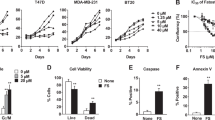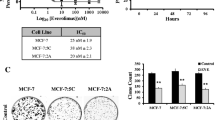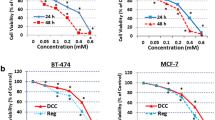Abstract
Purpose
The majority of breast cancers are estrogen receptor (ERα) positive making endocrine therapy a mainstay for these patients. Unfortunately, resistance to endocrine therapy is a common occurrence. Fatty acid synthase (FASN) is a key enzyme in lipid biosynthesis and its expression is commensurate with tumor grade and resistance to numerous therapies.
Methods
The effect of the FASN inhibitor TVB-3166 on ERα expression and cell growth was characterized in tamoxifen-resistant cell lines, xenografts, and patient explants. Subcellular localization of ERα was assessed using subcellular fractionations. Palmitoylation and ubiquitination of ERα were assessed by immunoprecipitation. ERα and p-eIF2α protein levels were analyzed by Western blotting after treatment with TVB-3166 with or without the addition of palmitate or BAPTA.
Results
TVB-3166 treatment leads to a marked inhibition of proliferation in tamoxifen-resistant cells compared to the parental cells. Additionally, TVB-3166 significantly inhibited tamoxifen-resistant breast tumor growth in mice and decreased proliferation of primary tumor explants compared to untreated controls. FASN inhibition significantly reduced ERα levels most prominently in endocrine-resistant cells and altered its subcellular localization. Furthermore, we showed that the reduction of ERα expression upon TVB-3166 treatment is mediated through the induction of endoplasmic reticulum stress.
Conclusion
Our preclinical data provide evidence that FASN inhibition by TVB-3166 presents a promising therapeutic strategy for the treatment of endocrine-resistant breast cancer. Further clinical development of FASN inhibitors for endocrine-resistant breast cancer should be considered.






Similar content being viewed by others
References
Menendez J, Lupu R (2017) Fatty acid synthase regulates estrogen receptor-α signaling in breast cancer cells. Oncogenesis 6(2):e299–e299
Robertson JF et al (2016) Fulvestrant 500 mg versus anastrozole 1 mg for hormone receptor-positive advanced breast cancer (FALCON): an international, randomised, double-blind, phase 3 trial. The Lancet 388(10063):2997–3005
Lupu R, Menendez JA (2006) Targeting fatty acid synthase in breast and endometrial cancer: an alternative to selective estrogen receptor modulators? Endocrinology 147(9):4056–4066
Dickler MN et al (2017) MONARCH 1, a phase II study of abemaciclib, a CDK4 and CDK6 inhibitor, as a single agent, in patients with refractory HR+/HER2− metastatic breast cancer. Clin Cancer Res 23(17):5218–5224
Hortobagyi GN et al (2016) Ribociclib as first-line therapy for HR-positive, advanced breast cancer. N Engl J Med 375(18):1738–1748
De Angelis C, Ignatiadis M, Piccart-Gebhart M (2020) Cyclin-dependent kinases 4 and 6 inhibitors (CDK4/6i) versus chemotherapy in luminal B early breast cancer: lessons from the CORALLEEN trial. Annals of Translational Medicine 8(21):1338
Desantis CE et al (2019) Breast cancer statistics. CA Cancer J Clin 69(6):438–451
Jones SF, Infante JR (2015) Molecular pathways: fatty acid synthase. Clin Cancer Res 21(24):5434–5438
Menendez JA, Lupu R (2007) Fatty acid synthase and the lipogenic phenotype in cancer pathogenesis. Nat Rev Cancer 7(10):763–777
Corominas-Faja B et al (2017) Clinical and therapeutic relevance of the metabolic oncogene fatty acid synthase in HER2+ breast cancer. Histol Histopathol 32(7):687
Kuhajda FP et al (1994) Fatty acid synthesis: a potential selective target for antineoplastic therapy. Proc Natl Acad Sci 91(14):6379–6383
Ventura R et al (2015) Inhibition of de novo palmitate synthesis by fatty acid synthase induces apoptosis in tumor cells by remodeling cell membranes, inhibiting signaling pathways, and reprogramming gene expression. EBioMedicine 2(8):808–824
Patel M et al (2015) Abstract CT203: Report of a first-in-human study of the first-in-class fatty acid synthase (FASN) inhibitor TVB-2640. Can Res 75(15):CT203
Heuer TS et al (2016) FASN inhibition and taxane treatment combine to enhance anti-tumor efficacy in diverse xenograft tumor models through disruption of tubulin palmitoylation and microtubule organization and FASN inhibition-mediated effects on oncogenic signaling and gene expression.
Brenner A et al (2015) First-in-human study of the first-in-class fatty acid synthase (FASN) inhibitor, TVB-2640 as monotherapy or in combination-final results of dose escalation.
Falchook G et al (2017) Abstract CT153: first in human study of the first-in-class fatty acid synthase (FASN) inhibitor TVB-2640. AACR.
WäsTER P et al (2011) Ultraviolet exposure of melanoma cells induces fibroblast activation protein-α in fibroblasts: implications for melanoma invasion. Int J Oncol 39(1):193–202
Brenner A et al (2017) Abstract P6-11-09: heavily pre-treated breast cancer patients show promising responses in the first in human study of the first-In-class fatty acid synthase (FASN) inhibitor, TVB-2640 in combination with paclitaxel. AACR.
Cariou S et al (2000) Down-regulation of p21WAF1/CIP1 or p27Kip1 abrogates antiestrogen-mediated cell cycle arrest in human breast cancer cells. Proc Natl Acad Sci 97(16):9042–9046
Doisneau-Sixou S et al (2003) Estrogen and antiestrogen regulation of cell cycle progression in breast cancer cells. Endocr Relat Cancer 10(2):179–186
Zadra G et al (2019) Inhibition of de novo lipogenesis targets androgen receptor signaling in castration-resistant prostate cancer. Proc Natl Acad Sci 116(2):631–640
Little JL et al (2007) Inhibition of Fatty Acid Synthase Induces Endoplasmic Reticulum Stress in Tumor Cells. Cancer Res 67(3):1262–1269
Viswanadhapalli S et al (2019) Estrogen receptor coregulator binding modulator (ERX-11) enhances the activity of CDK4/6 inhibitors against estrogen receptor-positive breast cancers. Breast Cancer Res 21(1):1–15
Chen CL et al (2013) Single-cell analysis of circulating tumor cells identifies cumulative expression patterns of EMT-related genes in metastatic prostate cancer. Prostate 73(8):813–826
Brigidi GS, Bamji SX (2013) Detection of protein palmitoylation in cultured hippocampal neurons by immunoprecipitation and acyl-biotin exchange (ABE). JoVE Journal of Visualized Experiments 72:e50031
Nair BC et al (2011) Roscovitine confers tumor suppressive effect on therapy-resistant breast tumor cells. Breast Cancer Res 13(3):R80
Wu Y et al (2018) Tamoxifen resistance in breast cancer is regulated by the EZH2-ERalpha-GREB1 transcriptional axis. Cancer Res 78(3):671–684
Viswanadhapalli S et al (2019) Estrogen receptor coregulator binding modulator (ERX-11) enhances the activity of CDK4/6 inhibitors against estrogen receptor-positive breast cancers. Breast Cancer Res 21(1):150
Fan P et al (2007) Long-term treatment with tamoxifen facilitates translocation of estrogen receptor α out of the nucleus and enhances its interaction with EGFR in MCF-7 breast cancer cells. Can Res 67(3):1352–1360
Steinman RM et al (1983) Endocytosis and the recycling of plasma membrane. J Cell Biol 96(1):1–27
Fu S et al (2011) Aberrant lipid metabolism disrupts calcium homeostasis causing liver endoplasmic reticulum stress in obesity. Nature 473(7348):528–531
Gong C et al (2020) Phosphorylation independent eIF4E translational reprogramming of selective mRNAs determines tamoxifen resistance in breast cancer. Oncogene 39(15):3206–3217
Geter PA et al (2017) Hyperactive mTOR and MNK1 phosphorylation of eIF4E confer tamoxifen resistance and estrogen independence through selective mRNA translation reprogramming. Genes Dev 31(22):2235–2249
Bollu LR et al (2015) Intracellular activation of EGFR by fatty acid synthase dependent palmitoylation. Oncotarget 6(33):34992
Röhrig F, Schulze A (2016) The multifaceted roles of fatty acid synthesis in cancer. Nat Rev Cancer 16(11):732
Lee G et al (2017) Post-transcriptional regulation of de novo lipogenesis by mTORC1-S6K1-SRPK2 Signaling. Cell 171(7):1545-1558.e18
Li L et al (2014) Epigenetic identification of receptor tyrosine kinase-like orphan receptor 2 as a functional tumor suppressor inhibiting β-catenin and AKT signaling but frequently methylated in common carcinomas. Cell Mol Life Sci 71(11):2179–2192
Li R et al (2019) ROR2 induces cell apoptosis via activating IRE1α/JNK/CHOP pathway in high-grade serous ovarian carcinoma in vitro and in vivo. J Transl Med 17(1):1–17
Fagan DH et al (2017) Acquired tamoxifen resistance in MCF-7 breast cancer cells requires hyperactivation of eIF4F-mediated translation. Hormones and Cancer 8(4):219–229
Author information
Authors and Affiliations
Corresponding author
Additional information
Publisher's Note
Springer Nature remains neutral with regard to jurisdictional claims in published maps and institutional affiliations.
Supplementary Information
Below is the link to the electronic supplementary material.
Rights and permissions
About this article
Cite this article
Gruslova, A., McClellan, B., Balinda, H.U. et al. FASN inhibition as a potential treatment for endocrine-resistant breast cancer. Breast Cancer Res Treat 187, 375–386 (2021). https://doi.org/10.1007/s10549-021-06231-6
Received:
Accepted:
Published:
Issue Date:
DOI: https://doi.org/10.1007/s10549-021-06231-6




